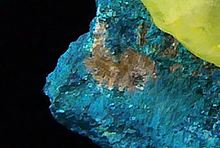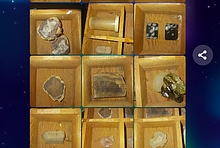Home PageAbout MindatThe Mindat ManualHistory of MindatCopyright StatusWho We AreContact UsAdvertise on Mindat
Donate to MindatCorporate SponsorshipSponsor a PageSponsored PagesMindat AdvertisersAdvertise on Mindat
Learning CenterWhat is a mineral?The most common minerals on earthInformation for EducatorsMindat ArticlesThe ElementsThe Rock H. Currier Digital LibraryGeologic Time
Minerals by PropertiesMinerals by ChemistryAdvanced Locality SearchRandom MineralRandom LocalitySearch by minIDLocalities Near MeSearch ArticlesSearch GlossaryMore Search Options
The Mindat ManualAdd a New PhotoRate PhotosLocality Edit ReportCoordinate Completion ReportAdd Glossary Item
Mining CompaniesStatisticsUsersMineral MuseumsClubs & OrganizationsMineral Shows & EventsThe Mindat DirectoryDevice SettingsThe Mineral Quiz
Photo SearchPhoto GalleriesSearch by ColorNew Photos TodayNew Photos YesterdayMembers' Photo GalleriesPast Photo of the Day GalleryPhotography
╳Discussions
💬 Home🔎 Search📅 LatestGroups
EducationOpen discussion area.Fakes & FraudsOpen discussion area.Field CollectingOpen discussion area.FossilsOpen discussion area.Gems and GemologyOpen discussion area.GeneralOpen discussion area.How to ContributeOpen discussion area.Identity HelpOpen discussion area.Improving Mindat.orgOpen discussion area.LocalitiesOpen discussion area.Lost and Stolen SpecimensOpen discussion area.MarketplaceOpen discussion area.MeteoritesOpen discussion area.Mindat ProductsOpen discussion area.Mineral ExchangesOpen discussion area.Mineral PhotographyOpen discussion area.Mineral ShowsOpen discussion area.Mineralogical ClassificationOpen discussion area.Mineralogy CourseOpen discussion area.MineralsOpen discussion area.Minerals and MuseumsOpen discussion area.PhotosOpen discussion area.Techniques for CollectorsOpen discussion area.The Rock H. Currier Digital LibraryOpen discussion area.UV MineralsOpen discussion area.Recent Images in Discussions
Fakes & Frauds"Magnetic Hematite" for sale in museums

18th Apr 2008 03:41 UTCHoward Heitner
18th Apr 2008 06:33 UTCJustin Zzyzx Expert
18th Apr 2008 10:35 UTCJolyon Ralph Founder
* "Citrine" (baked Amethyst)
* "Agate" (artificially dyed)
* "Smoky Quartz" (irradiated clear quartz from Arkansas or China)
* "Bornite" (chemically treated Chalcopyrite lumps)
Museums that should know better, such as the Natural History Museum in London, and the Royal Ontario Museum in Toronto are amongst the culprits. Can't someone from the departments there have a strong word with the buyers in the gift shop to say that either the stuff needs to be labeled to explain that it's not natural, or it needs to be withdrawn.
There are enough true natural materials available that these particular fake items don't really need to be stocked.
Jolyon

18th Apr 2008 11:39 UTCSpencer I. Mather

18th Apr 2008 13:51 UTCPete Nancarrow
To me it was important that young collectors just starting out were not misinformed about what they were spending their pocket money on, even if it was only a piece of massive pyrite or a rather chipped quartz crystal, and it only took a short while to scan over the trays of each delivery to spot and reject the obvious rubbish or wrongly labelled pieces. I would have thought that any major museum would consider this a valuable part of their educational function, and use of even a junior mineralogist's time, but perhaps if this is no longer happening, it is yet another symptom of cuts in science funding, and the "dumbing down" so prevalent in the world of media & education. At the time of the major changes in the Museum management in the 1980s, I remember remarking that it seemed to me that what I saw as the primary functions of a Museum - conservation, education and research, had been replaced by glossy trivial entertainment aimed at mass appeal; what I termed the "Disney" syndrome.
However, ramble over and back to the OP: "Magnetic Hematite"
In the context of doubtful pieces from Museum shops etc, a piece I was once asked to check by a friend who knew of my Museum work, was one of several crystals she had been given by another friend as "magnetic haematite". As she was rather doubtful about them she had brought them to me for another opinion. The one I tested is a single flat crystal about 30mm long, apparently a rather pitted, distorted scalenohedron, with an almost adamantine lustre (similar to a good Elba haematite) and quite obviously weakly ferromagnetic. It will swing a compass needle, and althought an ordinary hand magnet will not actually lift it, it gets noticeably lighter in the hand when the magnet is brought close above it. It is attracted to the magnet when suspended by a piece of cotton, and it can be tipped from a position of unstable balance when the magnet is brought near it.
The first impression was that it must be a pseudomorph of magnetite after haematite, but as SG and hardness are not reliably distinct for magnetite and haematite, I ran a Debye-Scherrer XRD analysis on a small sample scraped from several edges with a diamond file. All the sources gave red powder, and the XRD pattern was definitely that of haematite, with no indication of magnetite or maghemite lines on the film.
Following my tests, she gave the crystal I tested to me. Without grinding up the whole crystal for analysis, there is no way to be certain that it does not contain any inclusions of magnetite which are responsible for the magnetism, but I cannot envisage an environment which would allow a single crystal of haematite to include a significant mass of unoxidised magnetite in its core, and as all its features except for its anomalous magnetism (crystal form, lustre, streak, and XRD pattren) are all consistent with haematite, it is now in my collection labelled as "Magnetic haematite". (The locality given by the collector was Arzannah Island, Abu Dhabi, where these crystals are apprently called "black diamonds" by the locals!)
Pete N.
18th Apr 2008 13:55 UTCJolyon Ralph Founder
I still have a large number of those 1 pound specimens in plastic boxes that I bought from the shop as a kid at that time. Where now could you buy a Legrandite in a box from a museum gift shop? Great times, and thank you for your efforts.
It probably, in no small way, contributed to me doing what I do now.
Jolyon
18th Apr 2008 17:35 UTCUwe Kolitsch Manager

18th Apr 2008 21:47 UTCKatherine Dunnell
It is a fact of life in museums these days. At one point we (ROM) had a mineral shop that was vetted by the department, but those days are long gone. Most museum shops arent run by the museum they are housed in, but by a 3rd party company. We have no control what they buy, nor how they display and label the objects/specimens. We have tried to set our buyer up with reputable mineral dealers, but they still end up buying the low cost, big mark up junk that is mislabeled.
please see this link to find out more information ..
http://www.noteaccess.com/APPROACHES/Marketing.htm
very best
Katherine
Collections technician
ROM
18th Apr 2008 23:25 UTCSteve Hardinger 🌟 Expert
19th Apr 2008 00:02 UTCJolyon Ralph Founder
Jolyon

19th Apr 2008 02:12 UTCHoward Heitner

19th Apr 2008 02:19 UTCAlfredo Petrov Manager

19th Apr 2008 22:28 UTCDonald Vaughn

23rd Apr 2008 22:32 UTCAndrew Locock
It is sold here with a rather misleading label/disclaimer:
"Magnetic hematite is formed from finely powdered iron oxide and heated until it granulates. During this process a strong magnetic field is applied to the material so that the molecular poles line up to form a permanent magnet. Then it is cut into smaller blocks and polished to create magnetic hematite."
Although useful for demonstrating and teaching magnetism, it is very unfortunate that it is being marketed using mineralogical terminology. It is simply a synthetic ferrite magnet,
24th Apr 2008 11:41 UTCJolyon Ralph Founder
Thanks everyone, espeically to Andrew.
Jolyon

23rd May 2008 04:39 UTCChristine (Chris.) Johnson
I purchased a strong of Hematite beads simply because I liked the look of it.
I noticed the beads were magnetic, so had some serious doubts. After it broke, I ran one across a streak plate - the streak is an unattractive dark brown, not a trace of red. Ditto under the microscope. Left in damp, they rust a darkish brown, no sign of ocre or red ... and they do rust at the unpolished ends. Maybe gangue? Whatever it is, I suspect all the new age hematite is junk like this.
Another one to watch out for is necklaces etc etc made of Malachite. They look real and are more expensive then the rest of the junk. These streak clear, and do not fizz in acid. They look real enough, but are are coloured plastic.
The so called Moldavite has to be the worst when it comes to fake and prices being asked for it. Coloured glass for >NZ$60.
Chris. Johnson
NZ

7th Jun 2008 03:35 UTCJ. Michael Howard
I came upon an unusual situation here in Arkansas several years ago. One of our geologists always carried a small but strong magnet with him to the field and everywhere he visited, he found in soils a magnetic fraction...almost always spherical beads appearing to be concretions from 0.5 to 2.5 mm in diameter. Scattered in soils across numerous localities in the state.
When confronted as to what they were and why they were there...at first I was at a loss except to say since they are in soils and appear to be concretions, they must be some iron oxide/hyroxide.
But then a couple of years later, a researcher sent me a book he had written on magnetism and lodestone...wow! did the light bulb brighten! Seems anywhere lightning hits the ground where there is soil, any iron compounds become locally magnetized or at least susceptible to being attracted to a magnet! And i began to take a look at lightning data and attempted to extrapolate that back 10,000 years for the ~ age of many soils....Wow! Hard to find a square foot that has not been struck!
I just mention this because the public is always bringing bits of magnetic soil etc in for me to identify. And I thought the commenters here might find that interesting as a source of conversion of normal magnetite into lodestone. Thanks
7th Jun 2008 13:33 UTCUwe Kolitsch Manager

17th May 2009 15:45 UTCC. Hawke

17th May 2009 22:20 UTCsteven garza
About the ONLY time it might be UNhealthy & def UNwise to wear such, is during an MRI; otherwise, they are harmless.
Your friend, Steve
18th May 2009 13:55 UTCVik Vanrusselt Expert
18th May 2009 14:47 UTCRalph S Bottrill 🌟 Manager
18th May 2009 15:25 UTCJolyon Ralph Founder
Maybe a museum giftshop would be a good target to make a point.
Jolyon
18th May 2009 21:35 UTCDebbie Woolf Manager
-------------------------------------------------------
> It might be interesting to report someone in the
> UK selling this "magnetic hematite" to the Trading
> Standards office and see what happens.
>
> Maybe a museum giftshop would be a good target to
> make a point.
>
> Jolyon
Or how about a dealer at the next Kempton or Haywards Heath show ? alert Tradding Standards of the dates ??
BTW Alt+0163 will generate the £ sign.
;)

19th May 2009 17:45 UTCRuss Nobbs
FWIW, most of the beads on the market are molded rather than cut with bead mill or lapidary equipment. On close examination you can see the indentation around the holes that indicates a molded bead.
Once in a while we will get strands of hematite chips that appear (by the streak test) to be actual hematite. The surprisingly real chips usually come from suppliers in India.

29th Oct 2010 05:19 UTCTheresa Grose
Thank you, The retired BeadCatcher
29th Oct 2010 09:55 UTCRock Currier Expert

29th Oct 2010 14:06 UTCjacques jedwab
J.J.
29th Oct 2010 19:34 UTCStuart Mills Manager

29th Oct 2010 22:58 UTCAlfredo Petrov Manager

16th Jul 2011 16:52 UTCVito J. Catrambone Jr
I was the Senior Lead Operator for both the Offshore Production Platform and the Onshore Stabilization Process Facilities.
The "Arzanna Island" what we called "Black Diamonds" were all over the Island. The Island had a history of Volcanic Origin, During the formation of the Island is when the Black Diamonds were formed as I understood it. At what date in time they were formed I can't exactly remember from one of our geologists that were on our staff.
If you require any further information, feel free to e-mail me.
I worked all around the world until 2000 when I took Medical Disability due to Multiple Sclerosis.
Before my MS got to the state I am at now I used to Cut gemstones as a hobby with a Custom Designed All Stainless steel Faceter Machine.
Best Regards, Joe Catrambone

16th Jul 2011 22:09 UTCAlfredo Petrov Manager
17th Jul 2011 09:20 UTCRock Currier Expert

17th Jul 2011 11:53 UTCAlexandr E. Zadov
18th Jul 2011 04:21 UTCJim Bean 🌟

18th Jul 2011 12:43 UTCAlfredo Petrov Manager

14th Feb 2013 16:31 UTCLaura

16th Feb 2013 06:46 UTCAlfredo Petrov Manager

28th Feb 2013 00:34 UTCRolf Luetcke Expert
I was very happy to read Michaels comments since they seems to fit well with the pseudos I had found.

28th Feb 2013 04:02 UTCBill Cordua 🌟 Manager
28th Feb 2013 10:07 UTCTimothy Greenland
I'm awfully afraid that the question is not "Is it nice?"but "Is it profitable?". This sort of outright lying by those who really MUST know better makes me wild...
I shall now try to cool off again...
Cheers
Tim
28th Feb 2013 11:18 UTCRock Currier Expert
28th Feb 2013 14:18 UTCJason Evans
Jolyon, Is all Bornite/Peacock ore chemically treated Chalcopyrite? is there a way to tell if it is natural or treated?
Christine Johnson, please elaborate on "so called Moldavite" to me that seems to imply that all moldavite is fake, if you take the time to find a reputable source you can get genuine moldavite. yes it is just a naturally occurring green glass, found only in a small area on Earth and formed from the impact of a meteorite. I think it is worth every penny but thats just my opinion.
I remember some years ago in the Natural history museum in London they had some small but nice ruby crystals (or purplish red sapphire) or corundum if you prefer, They were mislabelled, I cannot remember what they were calling them, but they were selling for 50p, I wish back then I had the idea to buy the lot, i think I could have made a substantial profit! In that case I am glad that museum shops make the occasional mistake!

28th Feb 2013 14:43 UTCAlfredo Petrov Manager

28th Feb 2013 17:22 UTCHarold (Hal) Prior Expert
1st Mar 2013 11:17 UTCRock Currier Expert
1st Mar 2013 11:50 UTCUwe Kolitsch Manager
It's not black, but "copper-red to pinchbeck-brown, quickly tarnishing to an iridescent purplish surface" (Mindat page, see also http://rruff.info/doclib/hom/bornite.pdf).
1st Mar 2013 12:08 UTCRock Currier Expert

30th Apr 2013 19:10 UTCAmanda Hawkins

12th Jun 2013 16:59 UTCPhoenix
Phoenix

5th Dec 2014 01:34 UTCJoe Catrambone Jr.
I Just Saw This. Here It Is 2014, I Am In Hospice Now, But Stumbled On My Old Post.
Arzanah Island Is About 5 Miles From Das Island, In The Persian Gulf. It's Only A Few Miles In Diameter And Small, If You Need I Will Give The Coordinates For It.
Here Is The Google Maps Website For The island.
https://www.google.com/maps/@24.7858166,52.5585619,5569m/data=!3m1!1e3
If You Have Google Earth, Just Enter:
"Arzanah Island - United Arab Emirates"
Into The Search-Box And It Will Bring It Right-Up.
Best Regards, Vito J.(Joe) Catrambone Jr.
5th Dec 2014 12:36 UTCOwen Melfyn Lewis
-------------------------------------------------------
> "Magnetic hematite is formed from finely powdered
> iron oxide and heated until it granulates....."
This process is used to form a hematite simulant which is sold by the US manufacturer as 'Hematine' This material is commonly used to make attractive highly polished beads and retailed as hematite - else the happy-clappy crew would not buy it). It is extraordinarily tough in comparison with beads of a natural structure. My two-handed maximum grip on 10 in adjustable pliers will not crack open a 6mm bead. I have yet to resort to a club hammer as I'd like to find the pieces to examine them.

5th Dec 2020 12:06 UTCSandra Cooper




Mindat.org is an outreach project of the Hudson Institute of Mineralogy, a 501(c)(3) not-for-profit organization.
Copyright © mindat.org and the Hudson Institute of Mineralogy 1993-2024, except where stated. Most political location boundaries are © OpenStreetMap contributors. Mindat.org relies on the contributions of thousands of members and supporters. Founded in 2000 by Jolyon Ralph.
Privacy Policy - Terms & Conditions - Contact Us / DMCA issues - Report a bug/vulnerability Current server date and time: April 18, 2024 06:30:22
Copyright © mindat.org and the Hudson Institute of Mineralogy 1993-2024, except where stated. Most political location boundaries are © OpenStreetMap contributors. Mindat.org relies on the contributions of thousands of members and supporters. Founded in 2000 by Jolyon Ralph.
Privacy Policy - Terms & Conditions - Contact Us / DMCA issues - Report a bug/vulnerability Current server date and time: April 18, 2024 06:30:22











